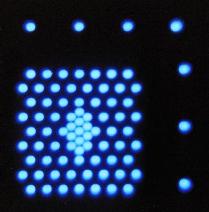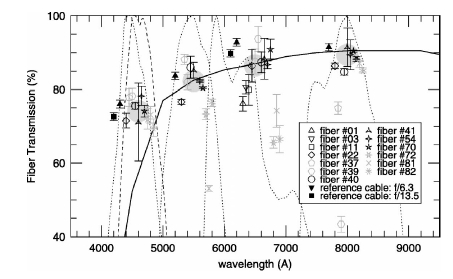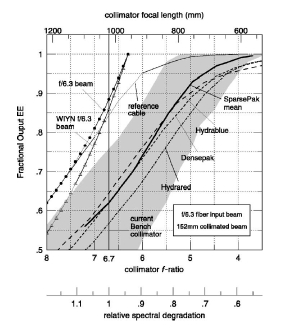 SparsePak IFU / Performance
SparsePak IFU / Performance  SparsePak IFU / Performance
SparsePak IFU / Performance | Transmission | Vignetting | Spectral Resolution |
| Focal-Ratio Degradation | Scattered Light | Sky Subtraction |
A summary of the primary results are presented here.
 Fiber
transmission (throughput) of 13 of the 82 SparsePak fibers and the
SparsePak Reference Cable, measured using the test-bench in our lab,
as described in the text and illustrated in Figure 13. Symbols denote
different fibers, as identified in the key, and are offset in
wavelength within groups for presentation purposes. Light symbols
(gray instead of black) are fibers for which the throughput variance
across bands was larger than 15%. These fibers either had
measurement-log notes indicating unsatisfactory setup of the pin-hole
image on the fiber face, or beam-mode measurement variances indicating
the lamp stability was poor. As such, these measurements should be
viewed as suspect, consistent with the unusually high or low measured
transmittance. The large, grey circles are the median of the 8 good
fiber measurements. The solid curve is the expected transmittance of
25.4m of Polymicro ultra-low OH- fused-silica fiber, based on
Polymicro's figures, combined with two silica-air interfaces (3.43%
per interface). The dotted curves represent the normalized broad-band
filter transmission, convolved with the CCD response function. From
left to right: B, V, R, I. For V,R,I, note the excellent
agreement between the measured and expected values, the measurable
difference between different fibers. The B-band measurements
appear high relative to expectations. The dashed curve curve takes
into account the effective band-pass given the expected fiber
transmittance. Not taken into account is the spectrum of the light
source. The likely effective wavelength of the B-band
measurements is 4900A. (Ref: Fig. 5, Bershady et al. 2004,
PASP, 116, 565.)
Fiber
transmission (throughput) of 13 of the 82 SparsePak fibers and the
SparsePak Reference Cable, measured using the test-bench in our lab,
as described in the text and illustrated in Figure 13. Symbols denote
different fibers, as identified in the key, and are offset in
wavelength within groups for presentation purposes. Light symbols
(gray instead of black) are fibers for which the throughput variance
across bands was larger than 15%. These fibers either had
measurement-log notes indicating unsatisfactory setup of the pin-hole
image on the fiber face, or beam-mode measurement variances indicating
the lamp stability was poor. As such, these measurements should be
viewed as suspect, consistent with the unusually high or low measured
transmittance. The large, grey circles are the median of the 8 good
fiber measurements. The solid curve is the expected transmittance of
25.4m of Polymicro ultra-low OH- fused-silica fiber, based on
Polymicro's figures, combined with two silica-air interfaces (3.43%
per interface). The dotted curves represent the normalized broad-band
filter transmission, convolved with the CCD response function. From
left to right: B, V, R, I. For V,R,I, note the excellent
agreement between the measured and expected values, the measurable
difference between different fibers. The B-band measurements
appear high relative to expectations. The dashed curve curve takes
into account the effective band-pass given the expected fiber
transmittance. Not taken into account is the spectrum of the light
source. The likely effective wavelength of the B-band
measurements is 4900A. (Ref: Fig. 5, Bershady et al. 2004,
PASP, 116, 565.)
 [LEFT] Relative encircled energy (EE) at an output f-ratio of f/6.3 as a
function of wavelength for 4 of the SparsePak fibers (labeled) fed
with a f/6.3 input beam. These represent four different measures of
FRD wavelength dependence for the 500 micron core Polymicro ultra-low
OH- fibers. Error-bars represent estimated observational
uncertainties. Wavelength offsets of points are for presentation
purposes. (Ref: Fig. 8, Bershady et al. 2004, PASP, 116, 565.)
[LEFT] Relative encircled energy (EE) at an output f-ratio of f/6.3 as a
function of wavelength for 4 of the SparsePak fibers (labeled) fed
with a f/6.3 input beam. These represent four different measures of
FRD wavelength dependence for the 500 micron core Polymicro ultra-low
OH- fibers. Error-bars represent estimated observational
uncertainties. Wavelength offsets of points are for presentation
purposes. (Ref: Fig. 8, Bershady et al. 2004, PASP, 116, 565.)
 [RIGHT] Fractional output encircled energy (EE) from fibers as a function of
WIYN Bench Spectrograph collimator focal ratio (bottom axis) or
collimator focal length (top axis). This assumes a 152mm collimated
beam diameter and that all fibers are fed with a f/6.3 beam. The mean
SparsePak beam profile (thick, solid line) the range for the 13
measured SparsePak fibers (grey shaded area), and reference cable
(thin solid curve) are based on laboratory measurements (cf. Figure
15) using the f/6.3 input beam shown as a thin solid curve with solid
circles. Comparable curves, as measured {\it on the telescope} for
Densepak (300 micron fibers), and the two Hydra cables (with ``blue,''
310 micron and ``red,'' 200 micron fibers), are shown for comparison
(private communication, P. Smith & C. Conselice; see text for further
details). These measurements use the WIYN f/6.3 beam (accounting for
the central obstruction -- see text), shown as the thin solid curve
with open triangles. The very bottom scale (relative spectral
degradation) indicates how the spectral resolution of the Bench would
alter (worst case) due to changes in system demagnification as a
function of changes in the collimator focal length at fixed camera
focal length. The current Bench has a f/6.7 collimator for a 152mm
collimated beam. This figure illustrates the effects of FRD on light
losses for the Bench Spectrograph, and how optimization trades might
be made between throughput and spectral resolution for redesign of the
Bench Spectrograph collimator. (Ref: Fig. 10, Bershady et al.
2004, PASP, 116, 565.)
[RIGHT] Fractional output encircled energy (EE) from fibers as a function of
WIYN Bench Spectrograph collimator focal ratio (bottom axis) or
collimator focal length (top axis). This assumes a 152mm collimated
beam diameter and that all fibers are fed with a f/6.3 beam. The mean
SparsePak beam profile (thick, solid line) the range for the 13
measured SparsePak fibers (grey shaded area), and reference cable
(thin solid curve) are based on laboratory measurements (cf. Figure
15) using the f/6.3 input beam shown as a thin solid curve with solid
circles. Comparable curves, as measured {\it on the telescope} for
Densepak (300 micron fibers), and the two Hydra cables (with ``blue,''
310 micron and ``red,'' 200 micron fibers), are shown for comparison
(private communication, P. Smith & C. Conselice; see text for further
details). These measurements use the WIYN f/6.3 beam (accounting for
the central obstruction -- see text), shown as the thin solid curve
with open triangles. The very bottom scale (relative spectral
degradation) indicates how the spectral resolution of the Bench would
alter (worst case) due to changes in system demagnification as a
function of changes in the collimator focal length at fixed camera
focal length. The current Bench has a f/6.7 collimator for a 152mm
collimated beam. This figure illustrates the effects of FRD on light
losses for the Bench Spectrograph, and how optimization trades might
be made between throughput and spectral resolution for redesign of the
Bench Spectrograph collimator. (Ref: Fig. 10, Bershady et al.
2004, PASP, 116, 565.)